For thousands of years, the Old Man of the Mountain stood watch over Franconia Notch and New Hampshire. Visit this Earthcache to learn the history of the iconic rock formation, it's devastating collapse in 2003, and the efforts to memorialize the "Great Stone Face".
For over one hundred years, a ride through Franconia Notch in New Hampshire included a view of a stunning geological coincidence - the profile of a man watching down over you from the side of Cannon Mountain.
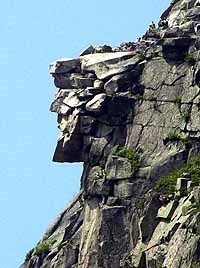
Nobody really knows how old the Old Man of the Mountain was when it fell in 2003. According to the official New Hampshire history, in 1805 early road surveyors Francis Whitcomb and Luke Brooks, part of a Franconia surveying crew, were the first white settlers to record observing the Old Man. So it was at least 198 years old.
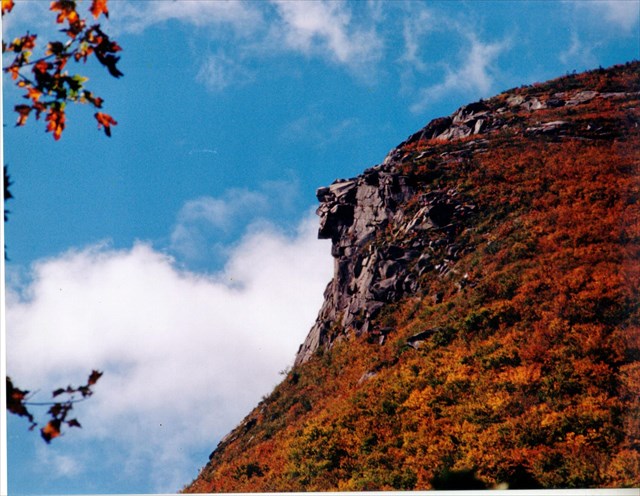
The protruding ledges that composed the Old Man Profile were probably not there when glacial ice flowed south through Franconia Notch. The most recent Ice Age began some 2 million years ago. The ice was so thick that it even covered the top of Cannon Mountain (4080 Feet).
Flowing glacial ice is filled with sand, gravel and rocks, which when dragged over the land surface, acts like a huge sheet of sandpaper, smoothing the rock underneath. This action shaped the valley between Cannon Mountain and the Lafayette Range into a U-shaped glacial valley. In NH they call these notches. There are also Crawford Notch and Pinkham Notch, to name just a few of them.
Scouring by flowing glacial ice would not produce sharp, protruding ledges such as are found on the cliffs of Cannon Mountain, thus the old man must have been formed AFTER the glacial ice had melted from this area. Glacial geologists now think the ice was gone from this part of NH by about 12,000 years ago.
Water freezing and thawing in cracks of the then exposed walls of Franconia Notch split off pieces of the granite. Chance removal of just the right pieces, produced a set of five ledges, that when viewed from just the right angle, had an uncanny likeness to a man’s profile.

Since his discovery in 1805, the Old Man of the Mountain was the spirit of Franconia Notch and New Hampshire. Visited by everyone from poets to presidents to generations of families for whom a summer was not complete without going to the White Mountains and saying hi to him, he was familiar, comforting and inspiring. The five massive ledges that comprised the visage defied gravity, perhaps far longer than if he did not have the help of human hands, ingenuity and remarkable dedication.
Were it not for the intervention of a host of caring people that spanned more than 100 years, the Old Man would likely have long ago tumbled into Profile Lake long before it did. It was the Appalachian Mountain Club that first discovered the Old Man’s forehead was slipping in 1872, but no one knew how to stop it. It would be another 40 years before the Rev. Guy Roberts and Quincy, MA quarryman Edward Geddes devised a series of turnbuckles that anchored the slipping stone to the ledge.
In the 1960's, Niels Nielsen (pictured below), a bridge superintendent for the State of New Hampshire joined the team that inspected the Old Man every year. Nielsen eventually became the official caretaker of the Old Man of the Mountain, leading trips over the side of the profile to repair cracks in the granite caused by the freezing and thawing cycle.
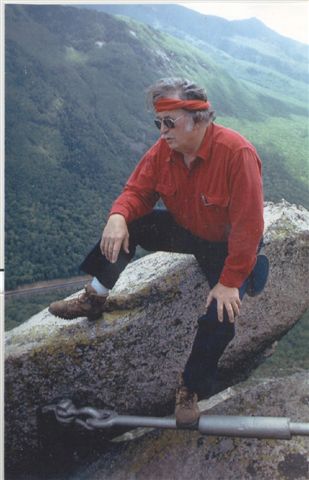
Nielsen and his team, which included his son David, also built "sluiceways" along the Old Man to divert rainwater away from the cliff face as seen in this picture:
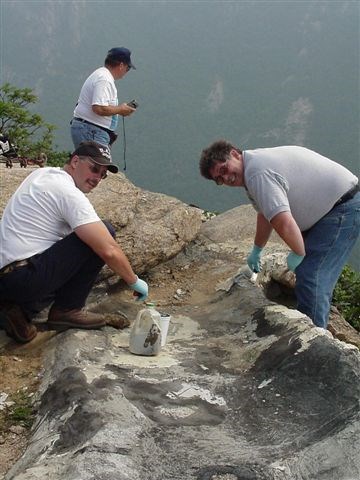
Niels Neilsen often said that without the intervention of man, the Old Man would probably have tumbled some time ago. But thanks to a century of fierce dedication by generations of men and women - the caretakers - the Old Man's vigil watching over the Granite State lasted into the 21st century.
The granite that makes up Cannon Mountain is called Conway Granite. Jurassic in age, it was intruded as magma into the rocks of the notch area during the time of the dinosaurs, some 180 million years ago. It’s pinkish color comes from one of the minerals that make up the granite. Called feldspar, this mineral slowly crumbles over time as water chemically breaks down the feldspar. This along with frost action eventually made the lower ledges so weak that on the night of May 3, 2003 the lower ledge could no longer support the massive weight above. Turnbuckles and iron rods, installed over time to hold the separate pieces of the Old Man together, could not hold the weight either. The front rocks of the Old Man pitched forward and fell onto the talus slope below.

Ironically…the processes of weathering and erosion that created the rock profile, sometime after the end of the Ice Age, continued to work on the rocks making up the Old Man and caused it to eventually fall.
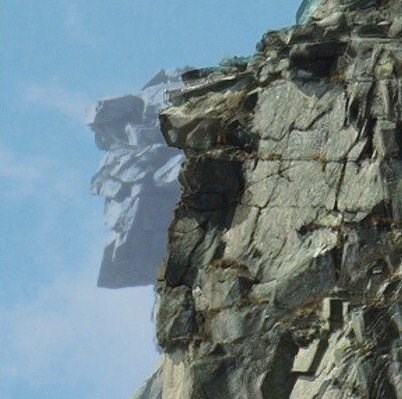
After the collapse, the Old Man of the Mountain Legacy Fund was created to explore plans for a permanent memorial to this New Hampshire institution. The fruits of the labors of the fund’s members are what you see today at the plaza you are standing in. The “Steel Profilers", which, when aligned with the Cannon Cliff above, create what the profile looked like up on the cliff overlooking the Franconia Notch. For those of you who remember seeing the Old Man when you were younger, the view will look very familiar to you. For those of you visiting this site for the first time, hopefully this memorial will help you to understand the importance of "The Great Stone Face" to the people of New Hampshire.
To log this Earthcache, please answer the following questions in an email to teamspadageocaching@gmail.com:
1. On the night that the Old Man collapsed, a storm produced high winds, heavy rains, and freezing temperatures. Based on what the sign “A Delicate Balance” says about the potash feldspar contained in the granite, why do you think the Old Man collapsed on the particular day that it did?
2. The large metal rod at the plaza was a turnbuckle once used to support the weight of the granite slabs that made up the Old Man’s “forehead”. According to the sign at the plaza, how much does this remaining piece weigh?
3. According to the sign “A Delicate Balance”, approximately what percentage of "Block 5" was cantilevered out over the cliff? How did this lead to the Old Man's collapse?
4. Take a picture of you or your team at the plaza with your GPS (if applicable) and include in your log. (Optional)
5. If you visited the Old Man before he collapsed in 2003, please share a personal memory of your previous visit in your log. (Optional)
Special thanks go out to the following people who helped make this Earthcache possible:
- Dick Hamilton, Chairperson for the Old Man of the Mountain Legacy Fund.
- Patrick Hummel, Volunteer Program Coordinator for New Hampshire State Parks.
Winter Access: Please note that the plaza walkways may not be fully maintained during the wintertime, so the terrain rating may be higher following snowfall.